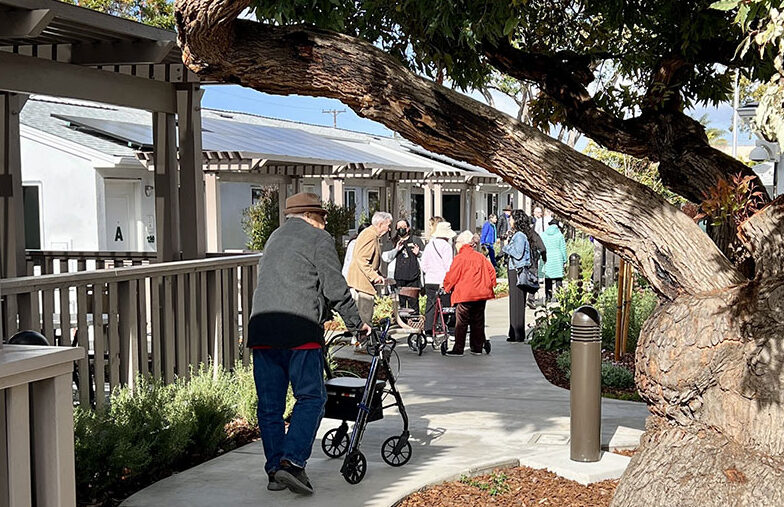In January, a new memory care neighborhood made its debut at Fredericka Manor, a Front Porch life plan community in Chula Vista, CA. The innovative 22-apartment neighborhood—the second at Fredericka Manor—is the latest iteration of the organization’s Summer House memory care model, which is in place at seven Front Porch communities in Southern California and the Bay Area.
Though the Front Porch model, first launched at Walnut Village in Anaheim in 2009, shares commonalities with other neighborhood-based memory care models, the Summer Houses—home to 152 residents in total—have some unique features.
Modern design and a lot of sun exposure, as well as interior details like roll-in showers and bathrooms, are included to meet the needs of memory care residents, says Justin Weber, executive director of Wesley Palms in San Diego. Most of the homes are studio apartments, typically in the range of 360 square feet, although a small number of larger apartments, 567 square feet or larger, are set aside for couples. In every community, maximizing comfort, freedom, and quality of life for residents living with dementia is a priority.
Summer Houses are designed with community-building in mind. Those at Fredericka Manor and Wesley Palms consist of individual cottages, with front porches and landscaped outdoor walkways, clustered around a “clubhouse” where meals are served and life enrichment and other activities are held. Other Summer House sites were incorporated into existing buildings with more traditional architecture and have less outdoor exposure, but all feature community gardens and courtyards enabling residents to enjoy the California weather, and common areas for resident engagement.
Technology is an important part of the model. With help from the Front Porch Center for Innovation and Wellbeing, the Summer House rooms are equipped with sensors from StackCare, a passive monitoring system that tracks activity levels, sleep hours, bathroom visits, and room temperatures, accessible with an app for staff and family members. The system can identify behavioral changes that suggest possible health issues, such as urinary tract infections, early in their progression. Residents’ daily lives are enhanced by engagement technologies, including Music and Memory, which brings personalized music playlists to residents; robotic and audio-animatronic pets; and wellness-focused content and engagement technology from LifeLoop. Two of the Summer Houses, at Wesley Palms and Vista del Monte in Santa Barbara, are equipped with sensory rooms, modeled on the Snoezelen concept. “It has a projector, speakers, a bubbler on the wall, special lighting, and it’s hooked up via Alexa to YouTube,” says Weber.
Unlike some memory care models, the Summer Houses do not rely on universal workers; housekeeping, dining, and maintenance staff come in from other parts of the community. Caregivers, Weber says, have special training and work full-time in the Summer Houses, but their resident assignments do change: “We switch them every couple of weeks […] and that’s really for observation and oversight purposes. If you get too comfortable with the same residents, sometimes you allow them to get into routines that can be detrimental.”
“Our job as a staff is to make the operations match the environment, in my opinion,” adds Weber. “The environment is really the differentiator, because you’ve got your own place, and it feels like you’re walking through a park-like neighborhood. It’s very peaceful, so I feel that the levels of anxiety are much lower here. Nobody ever wants to get dementia and have to live in memory care. But we’ve got [other] residents who go over there and volunteer simply because they feel like it’s the right thing to do—and it’s a good environment for them to be in.”
Photo: Fredericka Manor’s newest Summer House community. Photo courtesy of Front Porch.
Do you have a story of innovation in care and services to tell? The LeadingAge Story Collector, powered by Greystone, makes it easy to submit yours. Try it now.

 Shutdown Week Three: Impact of Ongoing Closure on Affordable Housing
Shutdown Week Three: Impact of Ongoing Closure on Affordable Housing CMS Publishes Draft OASIS-E2 Guidance Manual
CMS Publishes Draft OASIS-E2 Guidance Manual CMS Debuts Models: ACCESS, ELEVATE and LEAD
CMS Debuts Models: ACCESS, ELEVATE and LEAD


